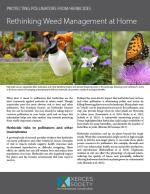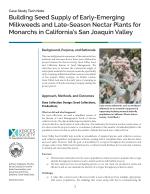As a science-based organization, the Xerces Society produces dozens of publications annually, all of which employ the best available research to guide effective conservation efforts. Our publications range from guidelines for land managers, to brochures offering overviews of key concepts related to invertebrate conservation, from books about supporting pollinators in farmland, to region-specific plant lists. We hope that whatever you are seeking—whether it's guidance on making a home or community garden pollinator-friendly, advice on developing a local pesticide reduction strategy, or detailed information on restoring habitat—you will find it here!
Find Publications
Use the search functions to sort by publication type (books, guidelines, fact sheets, etc.), location, and/or subject (agriculture, gardens, pollinators, pesticides, etc.).
The EPA should require registrants of neonicotinoid products to review all their product labels to ensure each one includes a stated seasonal maximum application rate. Clarity on the legal limits on the amount of a pesticide that can be applied during a single growing season can significantly reduce the amount of a pesticide used, thus reduce pollinator exposure. Prompting the necessary corrections will reduce the likelihood of seasonal over-applications.
The EPA requires that labels for clothianidin, dinotefuran, imidacloprid, and thiamethoxam products, designed for foliar application, include an "infographic" and warning about the risk to pollinators. Other products containing these chemicals that are applied via soil drench, basal bark spray, or trunk injection do not require a warning. Due to the systemic nature as well as the persistence of these chemicals, all products containing a neonicotinoid, regardless of the application method, should contain the pollinator warning.
Pest Management Practices to Protect Pollinators




